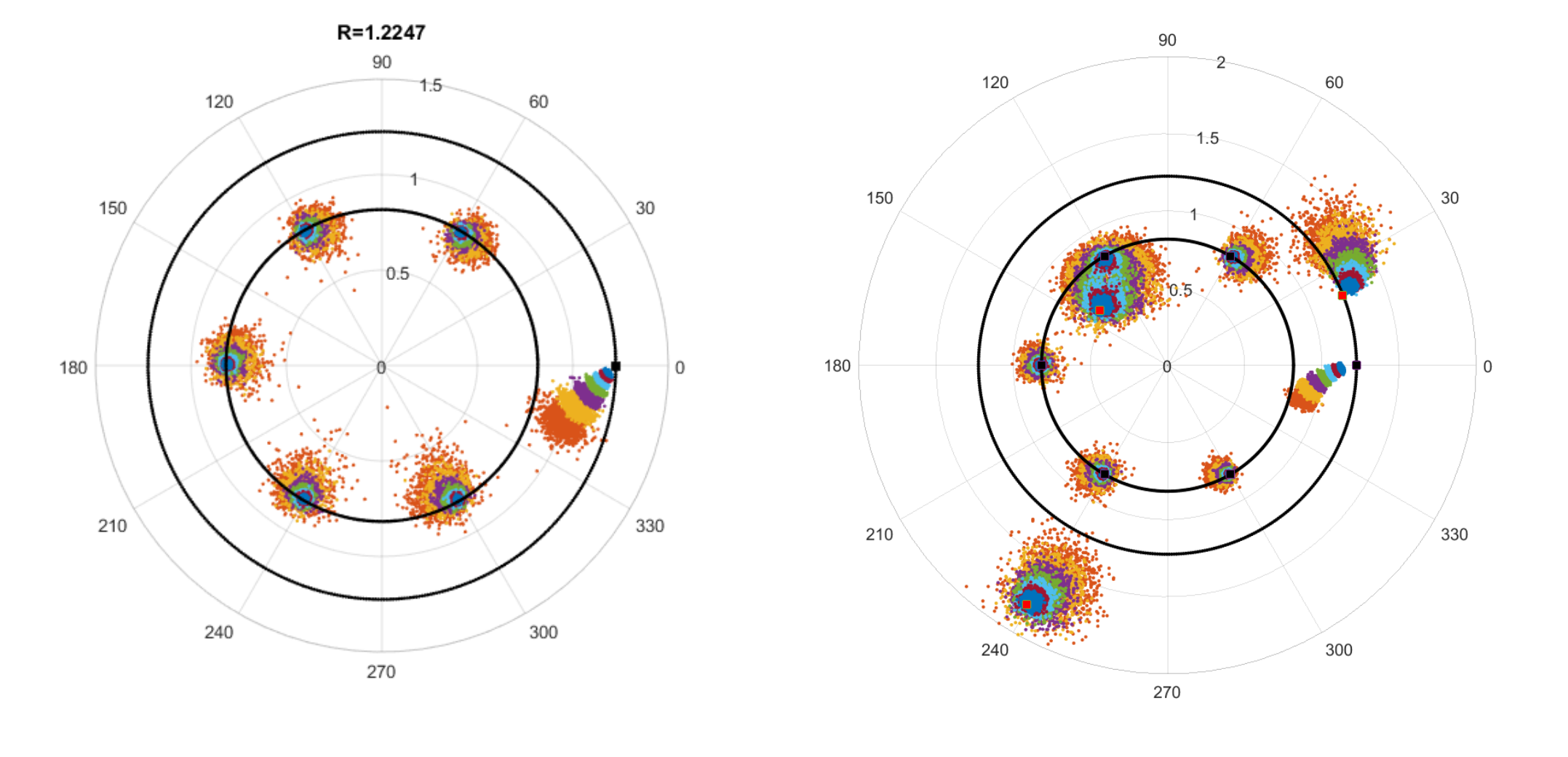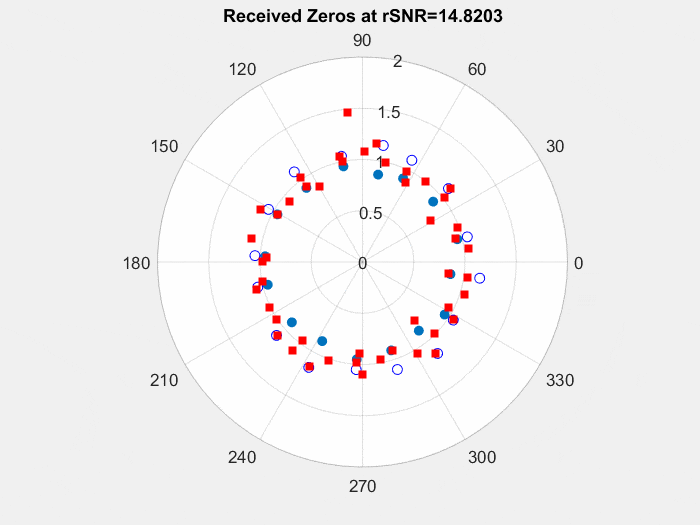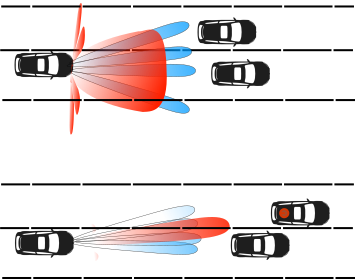MOXZ Principle
The MOXZ Principle is to encode the information in the location of the zeros of the transmitted signals z-transform. In the absence of additive noise, the zero structure of the signal is perfectly preserved at the receiver, regardless of the channel impulse response (CIR) realization. With a proper selection of the zero locations, we showed that MOCZ is not only invariant to the CIR, but also robust against additive noise. Furthermore, from a simple zero testing algorithm we engineered an extremely reliable and low-complexity decoder which enables low-power and low-latency.

Zero Perturbation
This image shows a Zero Constellation for a Binary MOXZ signal with K=6 Conjugate-reciprocal zero pairs on circles (black) with radii R=1.225 and 1/R=0.816 under an additive noise perturbation. The more red the color, the higher the noise power. Numerating the bit order from the positive real-axis counter-clockwise, this transmit constellation corresponds to the data-message [1 0 0 0 0 0]. The right picture shows the same 6 transmit zeros observed in a random channel of length L=4, resulting in 3 (red) channel zeros. In this case, the DiZeT (Direct Zero Testing) decoder or a root finding decoder would decode the transmit message error-free.
Physical Layer Security
The animation shows the zeros of random BMOXZ signals for K=33 conjugated-reciprocal zero-pairs (blue circles). The actual transmitted zeros are the filled blue circles. The red squares are the received noisy zeros in the presence of an i.i.d Channel impulse response of length L=16, generating 15 random channel zeros.
In this case, we changed the zero-constellations by phase and radii, such that it looks like a random zero-codebook, which makes it harder to identify the constellation/modulation scheme. The constellation alternation can be seen as a secret analog physical layer code. Without this code it is impossible to identify the data zero neither it is possible to separate the data zeros from the channel, which gives BMOXZ an intrinsic physical layer security.

RTT and AoA for Real-Time-Location-Systems
Real-Time-Location-Systems (RTLS) with Ultrawideband (UWB) signals have the ability to locate the 3D position of a tag with accuracy of a few centimeters. RTLS based on radio signals, can use two principles: obtaining distance from time measurements and directions from angle measurements. To calculate the 3D position of the tags the reader will use a phase-array to determine the Angle-of-Arrivals (AoA) of desired tags, i.e., azimuth and elevation angles. The radar properties of the MOXZ Signals can be used to make accurate Round-Trip-Time (RTT) measurements to calculate the distance between reader and Tag. Combining angle and distance allows accurate relative 3D position. The information will then be forwarded by the reader via a cellular link to the cloud.
Vehicle-To-Everything (V2X)
To make autonomous driving reality, safety and reliability targets have to be met which have to exceed human performance by magnitudes. Since autonomous vehicle will roll-out over time, a transition phase will exist in which humans and machines will operate at the same time. To avoid catastrophic accidents, the autonomous vehicles have therefore also to be reliable against human misbehavior. This requires not only sophisticated AI and computing power, but also a physical system which allows reliable communication between other vehicles and sense at the same time their environment, all in the order of milliseconds! There, the term V2X (Vehicle-To-Everything) refers to communications between different vehicles (V2V - Vehicle-To-Vehicle) as well as communications between vehicle and infrastructure (V2I - Vehicle-To-Infrastructure).
To operate reliably day or night, in good and bad weather conditions, radar technologies have to be utilized. With a wide-transmitting beam, many objects can be targeted in one single transmission. However, due to the missing angle-accuracy, the direction of the received signal cannot be resolved. Hence narrow-beams of massive antenna-arrays have to be utilized to scan 360° of the surrounding. To achieve such a scan in milliseconds, transmissions in microseconds are needed to obtain a good enough angle-resolution of less than half a degree.
In V2V-JSAC (Joint-Sensing-And-communication) scenarios, the radar beams will also carry information from one vehicle to the other vehicle. While some of the radio-waves will bounce back from the targeted received vehicle, the transmitting vehicle can use this reflection to determine the direction and range of the targeted vehicle. Due to large bandwidths, needed to obtain position accuracy in centimeters, multiple delay paths will be resolved, which corrupt the communication and radar performance. Since MOXZ is invariant to such multipath corruptions, it will be the key-technology and enabler for V2V and especially V2X-JSAC use-cases.
